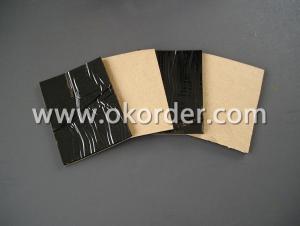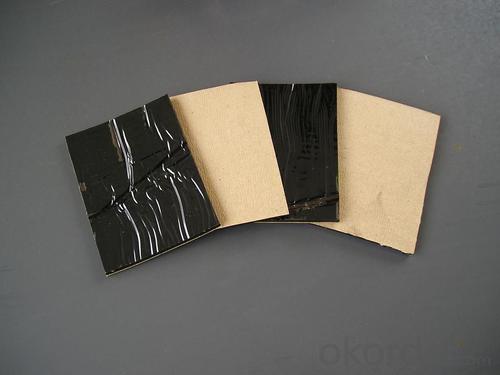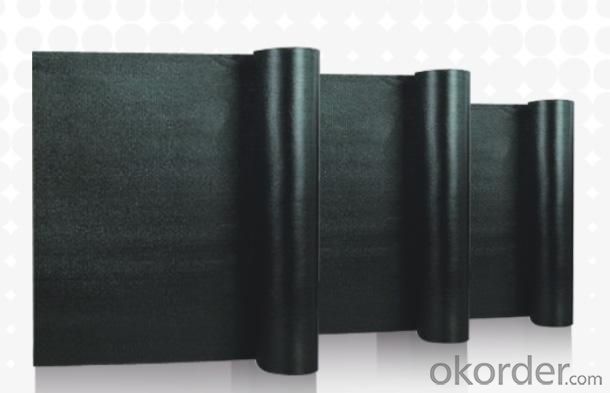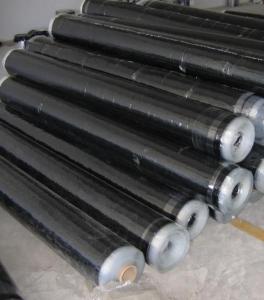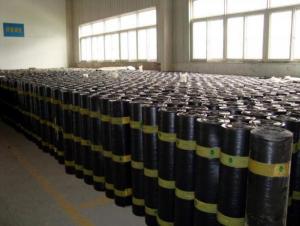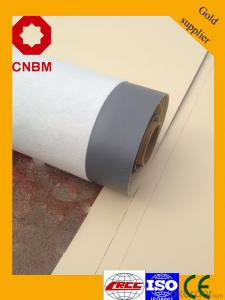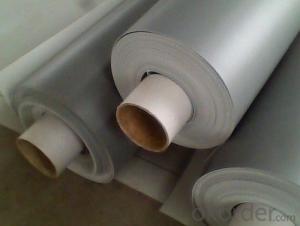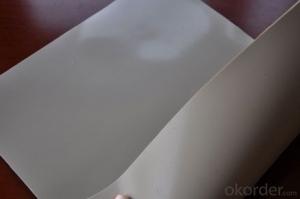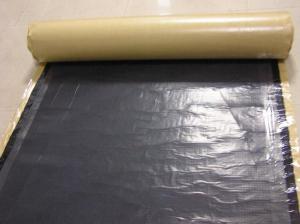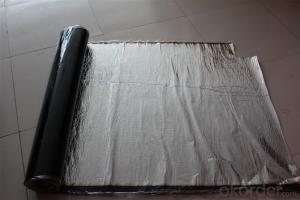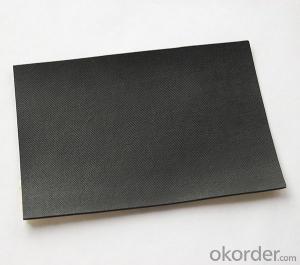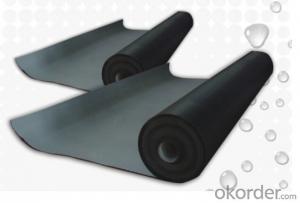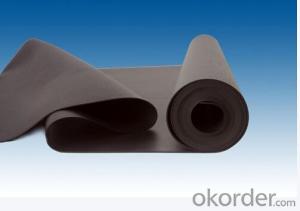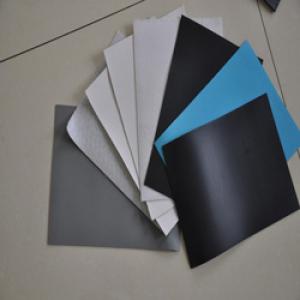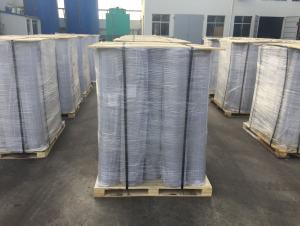Best Quality Self-adhesive Waterproofing Membrane
- Loading Port:
- China Main Port
- Payment Terms:
- TT or LC
- Min Order Qty:
- 2000 M2 m²
- Supply Capability:
- Above 10000M2 Per Month m²/month
OKorder Service Pledge
OKorder Financial Service
You Might Also Like
Description of Self-adhesive Waterproofing Membrane | Width | Length | Thickness | Weight | |
Styrene butadiene styrene(SBS) modified bituminous sheet materials (PE) | 1m | 10m | 2mm | 28kg/roll | |
| 1m | 10m | 3mm | 41kg/roll | |
| 1m | 8m | 4mm | 45kg/roll | |
Styrene butadiene styrene(SBS) modified bituminous sheet materials with mineral granules(M)
| 1m | 10m | 3mm | 45kg/roll | |
| 1m | 8m | 4mm | 47kg/roll | |
| 1m | 8m | 5mm | 57kg/roll | |
Styrene butadiene styrene(SBS) modified bituminous sheet materials with aluminum foil(Al) | 1m | 10m | 2mm | 29kg/roll | |
| 1m | 10m | 3mm | 42kg/roll | |
| 1m | 8m | 4mm | 46kg/roll | |
Pictures of of Self-adhesive Waterproof Membrane:
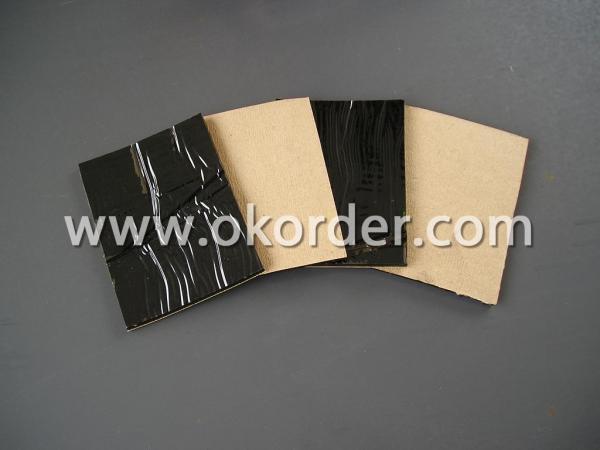

Characteristic of Self-adhesive Waterproof Membrane:
1)Self-adhesion without bonding agent,torching.
2)Good rubber elasticity,and elongation
3)Excellent adhension bond
4)Good self-coalescence
5)Safe application,no pullution
6)Excellent waterproof and high strength
7)Available for wet ground
8)Corrosion resistance and ageing-resistance
- Q: Can waterproofing membranes be used on green roofs?
- Indeed, green roofs can utilize waterproofing membranes. They serve as an indispensable element within green roof systems. The concept of green roofs involves a layer of plants and growing medium situated atop a waterproofing layer. It is this waterproofing layer that safeguards the building structure by preventing water infiltration and subsequent damage. The waterproofing membranes employed in green roof applications are specifically engineered to withstand the unique challenges posed by such installations, including exposure to water, UV radiation, and root penetration. These membranes are typically composed of durable materials such as PVC, TPO, or EPDM, renowned for their exceptional waterproofing capabilities. Moreover, certain waterproofing membranes used on green roofs may possess additional attributes like root resistance and UV stability, thereby ensuring the roof's longevity and imperviousness. Ultimately, the utilization of waterproofing membranes on green roofs plays a vital role in establishing a sustainable and enduring roofing system that not only provides water protection but also offers environmental advantages.
- Q: Does a waterproofing membrane require any specific preparation of the substrate before installation?
- Yes, a waterproofing membrane typically requires specific preparation of the substrate before installation. The substrate, which is the surface on which the membrane will be applied, needs to be clean, dry, and free from any contaminants or debris that could hinder the adhesion of the membrane. This usually involves removing any loose materials, such as old paint or sealants, and smoothing out any uneven surfaces. Additionally, it may be necessary to repair any cracks or damage in the substrate to ensure a proper and effective installation of the waterproofing membrane. Following the recommended preparation procedures will help to maximize the performance and durability of the membrane, ensuring its effectiveness in preventing water penetration and protecting the underlying structure.
- Q: Can a waterproofing membrane be used for a balcony deck?
- Indeed, a balcony deck can be protected by utilizing a waterproofing membrane. It is a highly recommended solution for shielding balcony decks against water damage. The primary purpose of a waterproofing membrane is to establish a barrier that hinders the infiltration of water into the underlying structure. It effectively safeguards the deck from various moisture-related problems such as rot, mold, and deterioration. This membrane is typically applied in either liquid or sheet form, effectively covering the entire surface of the balcony deck to create a seamless and impenetrable layer. Acting as a shield, this membrane ensures that any water coming into contact with the deck is effectively repelled and diverted away. By incorporating a waterproofing membrane, you can successfully prolong the lifespan of your balcony deck and uphold its structural integrity for many years to come.
- Q: Can a waterproofing membrane be used for a residential building facade?
- A residential building facade can utilize a waterproofing membrane. This material is applied to the exterior surface of the building to prevent water from penetrating and damaging the structure due to moisture. It proves particularly beneficial for residential buildings that are exposed to different weather conditions. The utilization of a waterproofing membrane for a residential building facade offers several advantages. Firstly, it prevents water from seeping through the facade and causing harm to the interior walls, insulation, and other building materials. This ensures a dry and comfortable living environment inside the house. Moreover, a waterproofing membrane extends the lifespan of the building facade by acting as a protective barrier against moisture and water-related issues like mold, mildew growth, and efflorescence. This condition causes discoloration and deterioration of the facade over time due to mineral deposits from water. Furthermore, this type of membrane enhances the energy efficiency of a residential building. It achieves this by preventing water infiltration, thereby maintaining proper insulation and reducing air leakage. This, in turn, reduces the energy required for heating or cooling the building. However, it is crucial to select the appropriate waterproofing membrane for the specific requirements of the residential building facade. There are several options available, including liquid-applied membranes, sheet membranes, and spray-applied membranes. Each option has its own advantages and limitations. Therefore, consulting a professional waterproofing contractor or architect is advisable to determine the most suitable membrane system for the project. Additionally, proper installation and regular maintenance are essential to ensure the effectiveness and longevity of the waterproofing membrane on the residential building facade.
- Q: Can a waterproofing membrane be used for plant rooms?
- Indeed, plant rooms can benefit from the utilization of a waterproofing membrane. These rooms frequently accommodate machinery and equipment that necessitate safeguarding against water and moisture. Employing a waterproofing membrane can effectively avert water-related harm to both the plant room and its enclosed equipment. By establishing a protective barrier, the membrane effectively prohibits the infiltration of water into the walls, floors, and ceilings of the plant room. This becomes particularly crucial in regions prone to water leaks or condensation. Waterproofing membranes are meticulously engineered to endure diverse environmental circumstances, guaranteeing enduring protection for plant rooms.
- Q: Can a waterproofing membrane be used in crawlspaces or basements?
- Using a waterproofing membrane in crawlspaces or basements is highly recommended. These areas are prone to water seepage and high humidity levels, which can cause mold growth, structural issues, and damage to stored items. By effectively sealing the foundation walls and floor, a waterproofing membrane acts as a barrier against water intrusion. It creates a watertight seal that keeps the space dry and protected. Furthermore, waterproofing membranes help control moisture levels by reducing condensation and humidity, creating a healthier and more comfortable environment. Overall, using a waterproofing membrane in crawlspaces or basements is crucial for ensuring the structure's longevity and integrity and protecting against potential water-related problems.
- Q: Can a waterproofing membrane be used for foundation walls and footings?
- Yes, waterproofing membranes are commonly used for foundation walls and footings to prevent water infiltration and moisture damage. They provide an effective barrier against water and help maintain the structural integrity of the foundation.
- Q: Can waterproofing membranes be used in swimming pools?
- Indeed, swimming pools can make use of waterproofing membranes. To prevent water leakage and safeguard the pool's structural integrity, it is common practice to employ waterproofing membranes in swimming pools. These membranes, often constructed from sturdy materials like PVC or EPDM, are specifically engineered to endure continuous exposure to water and pool chemicals. They are applied to the concrete or other pool structures, forming a watertight barrier that thwarts any seepage of water. Furthermore, waterproofing membranes offer an added layer of defense against cracks, corrosion, and other types of harm, thus guaranteeing the long-lastingness and resilience of the pool.
- Q: What is rigid waterproof, flexible waterproof?
- 3, not all waterproof only sub-rigid waterproof and flexible waterproof, such as metal roofing. Basement concrete structure waterproofing is usually not called rigid waterproof.
- Q: Does a waterproofing membrane require any special considerations for installation in earthquake-prone areas?
- Yes, a waterproofing membrane does require special considerations for installation in earthquake-prone areas. In these areas, the ground is more susceptible to movement and shaking, which can significantly impact the integrity of the waterproofing system. Therefore, it becomes crucial to take additional precautions to ensure that the membrane is properly installed and capable of withstanding seismic activity. One important consideration is the selection of the waterproofing membrane itself. It is recommended to choose a membrane that has been specifically designed and tested to withstand seismic activity. These membranes are usually more flexible and have higher tensile strength to accommodate ground movement during earthquakes. Additionally, the installation process should be executed with utmost care and attention to detail. The membrane should be properly anchored or secured to the substrate using appropriate fasteners and adhesives. Reinforcement techniques such as the use of reinforcing fabric or mesh can also be employed to enhance the membrane's resistance to movement. Furthermore, it is essential to ensure that all seams and joints in the membrane are properly sealed and reinforced. Special attention should be given to areas that are more prone to movement, such as corners, edges, and penetrations. Using compatible and high-quality sealants or adhesives will help maintain the integrity of these vulnerable points. Regular inspections and maintenance are also crucial in earthquake-prone areas. Inspecting the membrane periodically for any signs of damage, such as cracks or separations, allows for early detection and timely repairs. Additionally, it is vital to have a contingency plan in place to address any potential damage that may occur during an earthquake, including emergency repair procedures. In summary, installing a waterproofing membrane in earthquake-prone areas requires careful consideration and adherence to specific guidelines. By selecting an appropriate membrane, properly anchoring and reinforcing it, ensuring proper sealing of seams and joints, and conducting regular inspections, the waterproofing system can be better prepared to withstand earthquakes and provide long-lasting protection against water intrusion.
1. Manufacturer Overview
| Location | Hebei, China |
| Year Established | 2003 |
| Annual Output Value | Above US$ 10 Million |
| Main Markets | Europe; North America; Africa; Asia |
| Company Certifications | ISO 9001 |
2. Manufacturer Certificates
| a) Certification Name | |
| Range | |
| Reference | |
| Validity Period |
3. Manufacturer Capability
| a) Trade Capacity | |
| Nearest Port | Tianjin; Qingdao |
| Export Percentage | 50% - 100% |
| No.of Employees in Trade Department | 6- 10 people |
| Language Spoken: | English; Chinese |
| b) Factory Information | |
| Factory Size: | 100000 Square meters |
| No. of Production Lines | Above 5 |
| Contract Manufacturing | OEM Service Offered; Design Service Offered |
| Product Price Range | |
Send your message to us
Best Quality Self-adhesive Waterproofing Membrane
- Loading Port:
- China Main Port
- Payment Terms:
- TT or LC
- Min Order Qty:
- 2000 M2 m²
- Supply Capability:
- Above 10000M2 Per Month m²/month
OKorder Service Pledge
OKorder Financial Service
Similar products
Hot products
Hot Searches
Related keywords
